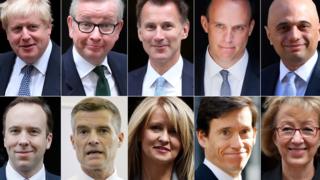Conservative leadership: 10 rivals face first ballot of Tory MPs
 Image copyright AFP
Image copyright AFP Conservative MPs will begin the process of choosing their new leader and the next prime minister later when a first round of voting is held in Parliament.
Voting will take place by secret ballot in the Commons, with a result expected some time after 13.00 BST.
Any of the 10 candidates who fails to secure at least 17 votes will be eliminated from the contest.
Further ballots will be held next week, with the two most popular MPs moving to a run-off of Tory party members.
The winner of the contest to succeed Theresa May is expected to be announced in the week of 22 July.
Boris Johnson – who launched his leadership campaign on Wednesday – is regarded as the frontrunner in the contest, with many more endorsements from MPs than any of his rivals.
Michael Gove, Sajid Javid, Dominic Raab and Jeremy Hunt have also received enough public endorsements to suggest they will make it through to the next round.
The remaining five candidates – Matt Hancock, Rory Stewart, Andrea Leadsom, Mark Harper and Esther McVey – are hoping to make it through and to build momentum.
More than a quarter of the 313 Conservative MPs eligible to vote have yet to state openly whom they are supporting – and, with it being a secret ballot, MPs could in theory vote differently to their declared intention.
The BBC’s political editor Laura Kuenssberg said there was plenty of time for the maths in the contest to change fundamentally but the first round of voting should provide a better idea of how the numbers are shaping up.
Who will replace Theresa May?
The winner of the contest to lead the Conservative Party will become the next prime minister.
Thursday’s ballot is taking place under new rules agreed by the Conservative Party earlier this month designed to speed up the contest.
Any candidate who fails to gain 5% of the vote in the first round will be out.
If all the ten candidates receive 17 votes then the one with the fewest votes will drop out of the contest.
If the two weakest candidates receive the same number of votes, then a decision will be taken between them on how to proceed. The candidates are allowed to vote for themselves.
Subsequent ballots are scheduled to take place on 18, 19 and 20 June to whittle down the contenders one by one until only two are left.
The final pair will then be put to a vote of members of the wider Conservative Party from 22 June, with the winner expected to be announced about four weeks later.
The contest has so far been dominated by Brexit and arguments over whether a deal can be renegotiated with the EU by 31 October and whether talking up a no deal Brexit is a plausible promise.







